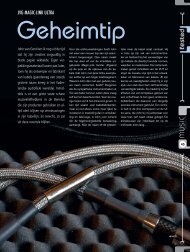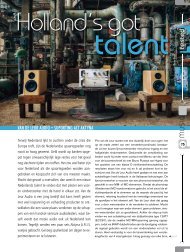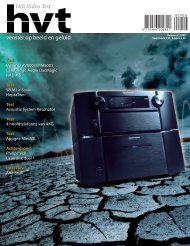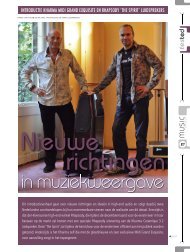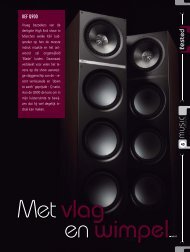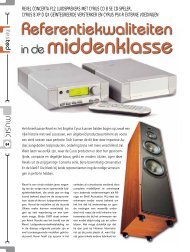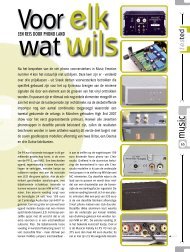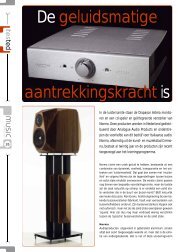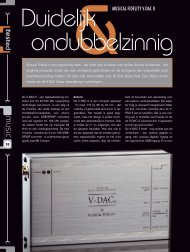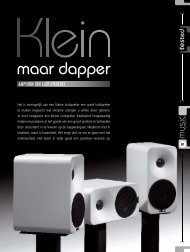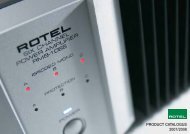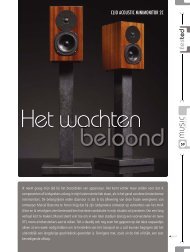The Official Magazine of ISE 2012 - Amazon S3
The Official Magazine of ISE 2012 - Amazon S3
The Official Magazine of ISE 2012 - Amazon S3
Create successful ePaper yourself
Turn your PDF publications into a flip-book with our unique Google optimized e-Paper software.
<strong>ISE</strong> visitors can make the KNX connection<br />
Last year at <strong>ISE</strong>, its association had 215 members. Today,<br />
that number stands at nearly 250. Close to 100,000 people<br />
subscribe to the association’s bi-annual journal. Over<br />
7,000 commercial products are now available that feature<br />
the technology. Industry standards may come and go, but<br />
KNX looks to be on a very positive upward path – and will<br />
once again be represented at <strong>ISE</strong> by the KNX Association.<br />
“One <strong>of</strong> the many things that makes KNX special is<br />
that, thanks to our certification scheme involving thirdparty<br />
test labs, products that feature the KNX standard<br />
are guaranteed to be interoperable,” says<br />
Joost Demarest, director <strong>of</strong> the KNX<br />
Association. “That means not just<br />
interoperability between one<br />
manufacturer’s KNX product and another<br />
– but also between KNX products from<br />
different application domains.”<br />
“<strong>The</strong> impact and benefit <strong>of</strong> that are<br />
clear,” he continues. “<strong>The</strong> user has a wide choice <strong>of</strong> many<br />
products from many vendors that can be combined<br />
together to a flexible and extendable smart-home<br />
installation.”<br />
<strong>The</strong> Association is always on the lookout for new<br />
members. “Regardless <strong>of</strong> the type <strong>of</strong> membership,<br />
becoming a member first and foremost allows a<br />
manufacturer to show that they are part <strong>of</strong> this worldwide<br />
community <strong>of</strong> providers <strong>of</strong> KNX solutions,” says<br />
Demarest. “As a licensee, a manufacturer can moreover<br />
become a contractual partner <strong>of</strong> the KNX IPR License<br />
Agreement, giving them access to any patents <strong>of</strong> fellow<br />
member companies that may exist on the KNX technology<br />
as described in the KNX standard. <strong>The</strong>y can then use<br />
these patents free <strong>of</strong> charge in products, if these are<br />
submitted to the KNX certification scheme for products.”<br />
Historically, KNX has perhaps been most associated<br />
with its applications in energy management – a topic<br />
close to the heart <strong>of</strong> many potential customers, both<br />
residential and commercial. “KNX can control many<br />
applications in homes and buildings,” points out<br />
Demarest. “It has already been extensively used to<br />
minimise energy costs such as lighting,<br />
sun shading and, last but not least, heating,<br />
ventilation and air-conditioning. It can also<br />
be used for load shedding: on the many<br />
KNX displays that are available, the<br />
customer can easily monitor not only the<br />
evolution <strong>of</strong> their energy consumption but<br />
can also – thanks to KNX energy actuators<br />
– find the source <strong>of</strong> a possible increase <strong>of</strong> consumption.”<br />
But, argues Demarest, KNX is about much more than<br />
just energy management. “Think <strong>of</strong> it as a highly intelligent<br />
superglue that enables all kinds <strong>of</strong> applications to be<br />
combined in a smart home,” he says, “including<br />
audiovisual applications. We’re hoping that <strong>ISE</strong> visitors<br />
will come to our stand (7V197) to find out for themselves<br />
about the wide variety <strong>of</strong> fields <strong>of</strong> application to which<br />
KNX can be applied.”<br />
www.knx.org<br />
AVnu Alliance continues to thrive<br />
Any initiative within the audiovisual industry to deliver a<br />
better end user experience is an initiative to be welcomed.<br />
Delivering that better experience is the goal <strong>of</strong> the AVnu<br />
Alliance, an organisation formed to promote understanding<br />
and adoption <strong>of</strong> the AVB (Audio Video Bridging) standards<br />
which will, their proponents claim, bring substantially<br />
superior AV streaming to the industry.<br />
A mark <strong>of</strong> the success <strong>of</strong> the AVnu Alliance is that, this<br />
year, its <strong>ISE</strong> stand (7Q220) will be larger than last year –<br />
indicative <strong>of</strong> an increased industry awareness and interest<br />
that is reflected in the fact that, in the intervening year,<br />
AVnu’s membership has grown from 29 companies to 40.<br />
“And,” points out Lee Minich, chair <strong>of</strong> the AVnu Alliance<br />
Marketing Work Group, “it’s important to note that those<br />
40 members are parent companies. If you take members,<br />
for example, like Bosch, Harman, LOUD Technologies<br />
and TC Group, that’s four members – but collectively,<br />
they represent more than 20 AV brands.”<br />
AVB has moved rapidly, and all <strong>of</strong> the IEEE AVB<br />
standards – with the exception <strong>of</strong> IEEE 1722.1, which is in<br />
its final stage – are now finalised and published. Minich<br />
points out that AVB is seeing growing adoption not just in<br />
the AV market, but in other markets such as automotive.<br />
“Many <strong>of</strong> the so-called ‘standards’ in the industry are<br />
actually what I'd classify as proprietary protocols,”<br />
Minich says. “If the technology is only available from a<br />
single source, then it is proprietary. AVB is different in<br />
that there are large number solution providers – chip<br />
manufacturers, s<strong>of</strong>tware vendors and so on - that are<br />
providing a broad range <strong>of</strong> technology options. “Many <strong>of</strong><br />
the so-called ‘standards’ in the industry are actually what<br />
I'd classify as proprietary protocols,” he says. “If the<br />
technology is only available from a single source, then it is<br />
proprietary. AVB is different in that there are large number<br />
solution providers – chip manufacturers, s<strong>of</strong>tware<br />
vendors and so on – that are providing a broad range <strong>of</strong><br />
technology options. What this means for manufacturers,<br />
and ultimately end users, is that the appropriate AVB<br />
implementation can be used for the appropriate<br />
application: for example, microphone implementation vs.<br />
a mega-channel DSP matrix solution.”<br />
“In the early days <strong>of</strong> AVnu Alliance, we were working<br />
hard to promote general education about AVB technology<br />
itself,” continues Minich. “We are now to the point with a<br />
number <strong>of</strong> large manufacturers with AVB product<br />
announcements, the fundamental work <strong>of</strong> AVnu in the AV<br />
industry is to educate as to the value and importance <strong>of</strong><br />
AVnu certified AVB products – so we will be featuring<br />
educational programmes at our <strong>ISE</strong> pavilion throughout<br />
the show, reinforcing the larger role AVnu plays in<br />
assuring interoperable member equipment, in addition<br />
to continuing to provide information about the underlying<br />
AVB technology.”<br />
www.avnu.org<br />
Rise<br />
55



